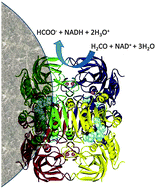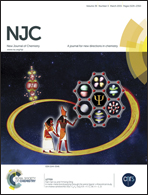Association of Pseudomonas putida formaldehyde dehydrogenase with superparamagnetic nanoparticles: an effective way of improving the enzyme stability, performance and recycling
Abstract
The association of formaldehyde dehydrogenase from Pseudomonas putida (FalDH) with two different magnetic nanoparticles led to distinct enzyme responses depending upon the chemical modification process applied. The magnetite nanoparticles coated with aminopropyltriethoxysilane (MagNP-APTS) exhibited a lower activity and stability, while magnetite coated with a silica shell and APTS (MagNP@SiO2APTS) afforded excellent results, improving the stability and performance of FalDH in relation to the free enzyme. Such differences were ascribed to unfavorable conformational changes in the MagNP-APTS–FalDH system, as indicated by the kinetics and Raman spectroscopy data, not discarding the possible interference from the exposed Fe(II)/(III) ions. The MagNP@SiO2APTS–FalDH catalyst could be successfully recycled by using an external magnet, keeping its highest performance close to 100%, during the first four cycles, and decaying slightly up to 70% after the 10th cycle.


 Please wait while we load your content...
Please wait while we load your content...